Navigating the vast landscape of audio speakers for music production becomes easier with insights from detailed studio monitor reviews aimed at both budding and experienced music producers. In our guide to the best studio monitors, we delve into selections that stand out for their precise sound reproduction and production-enhancing features. Discover the speakers that resonate with professionals and elevate your musical creations to new auditory heights.
Top 7 Audio Monitors
Navigating the vast sea of DJ audio equipment to find the best studio speakers can be a daunting task for both seasoned producers and newcomers to the music production world. Our curated list below aims to simplify this quest by highlighting models that stand out for their exceptional sound quality, durability, and value.
MACKIE CR4-X: Top Home Studio Monitors

| Power | 50 W |
| Frequency response | 70Hz – 20kHz |
| Inputs | 1/4″, 1/8″ and RCA |
| Digital connectivity | No |
| Dimensions (WxHxD) | 6.1 x 8.85 x 8.25 in / 15.5 x 22.5 x 20.9 cm |
| Weight | 10.1 lbs / 4.6 kg |
Pros
- Sound Quality: Offers clear and accurate sound reproduction, ideal for detailed mixing and mastering.
- Build Quality and Design: Durable construction with a sleek, professional appearance suitable for any studio setup.
- Affordability: Competitively priced, providing great value for aspiring DJs, producers, and audio enthusiasts.
- Versatility: Compact size and both Bluetooth and wired connectivity options make them suitable for various settings.
- Ease of Use: Straightforward setup and intuitive controls for hassle-free operation.
Cons
- Bass Response: Some users might find the bass response inadequate for genres that rely heavily on low-end frequencies.
- Limited Volume: Not the best choice for large spaces or live performance settings due to their size and power.
- No Room Adjustment Features: Lacks built-in room adjustment capabilities, requiring external solutions for acoustically challenging spaces.
- Connectivity Options: Limited to Bluetooth and basic wired connections, lacking USB or multiple TRS inputs for added flexibility.
Starting your journey in audio production with Mackie CR4’s positions you within reach of achieving optimal sound in a compact setting, making them a prime selection among the best studio monitors for a home studio. Mackie’s reputation shines through their range, offering commendable quality even at their more affordable end. Attention to detail is advised during playback due to the speakers’ somewhat colored frequency response and notable absence of deep bass, attributed to the constraints of their 4-inch woofers and sleek aesthetics. Despite these sonic adjustments, the CR4’s deliver a sound quality that exceeds expectations, given their size. The convenience is further amplified by frontally located power and volume controls, alongside an AUX input for additional device connectivity, enhancing their usability in any home studio setup.
YAMAHA HS5: Pro Studio Speakers
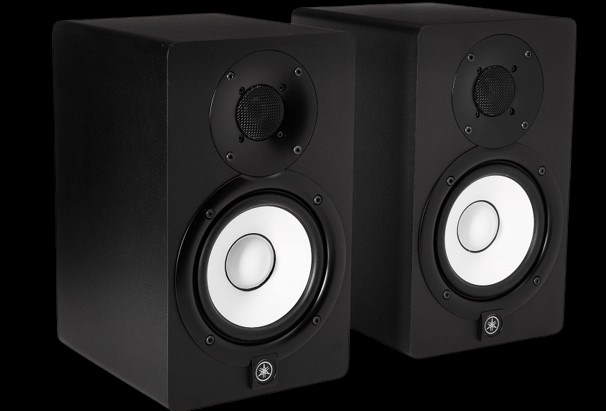
| Power | 70 W |
| Frequency response | 54 Hz – 30 kHz |
| Inputs | Combo input XLR / 6.3mm balanced jack |
| Digital connectivity | No |
| Dimensions (WxHxD) | 6.7 x 11.2 x 8.7 in / 17 x 28.5 x 22.2 cm |
| Weight | 11.7 lbs / 5.3kg |
Pros
- Exceptional Sound Accuracy: The YAMAHA HS5 is renowned for its flat frequency response, providing highly accurate sound reproduction that’s essential for critical mixing decisions.
- Build Quality: These monitors are solidly built, designed to last, and can withstand the demands of a professional studio environment.
- Detailed Highs and Mids: The HS5 excels in delivering crystal-clear highs and detailed midrange, making it easier to mix vocals and lead instruments.
- Room Control and High Trim Response Controls: Offers built-in room control and high trim response controls to adjust for room acoustics, enhancing their versatility in different mixing environments.
- Size and Aesthetics: Compact and elegantly designed, they fit well in small spaces and add a professional look to any studio.
Cons
- Bass Response: Due to their 5-inch woofer size, the HS5 monitors may lack the depth and punch in the bass for some users, potentially necessitating a separate subwoofer for full-range monitoring.
- Volume Levels: While sufficient for most nearfield monitoring situations, they might not achieve the high volume levels needed for larger spaces without distortion.
- No Bluetooth Connectivity: Lacks Bluetooth connectivity, which limits wireless audio streaming options for casual listening or convenience.
The intriguing tale behind the vintage Yamaha NS10 studio monitors revolves around their selection not for their acoustic charm, but rather their lack thereof. The idea was that achieving a pleasing mix on these challenging speakers ensured universal playback quality. With advancements in audio technology, today’s entry-level monitors surpass the NS10s in performance, yet the allure of owning a slice of authentic studio lore persists.
Among the contenders for best studio monitors for music production, the Yamaha HS5 series stands out as dedicated tools for precise mixing and monitoring. Absent of Bluetooth and elaborate EQ settings, and with minimal room correction capabilities, these monitors prioritize sonic accuracy. Excelling in their price segment, the HS5s guarantee that a mix perfected on them will resonate beautifully across diverse listening environments.
KRK Rokit RP7 G4: Prime Studio Monitor Speakers
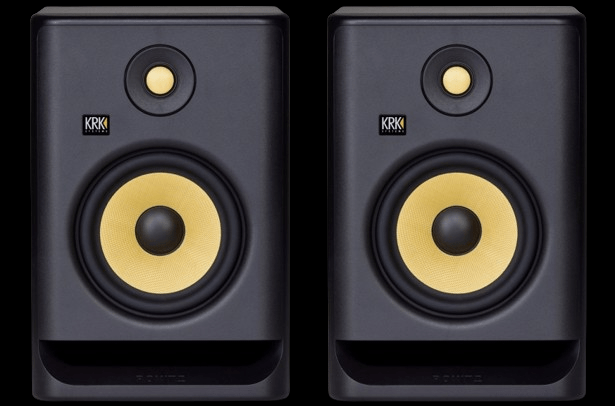
| Power | 145 W |
| Frequency response | 42 Hz – 40 kHz |
| Inputs | Combo input XLR / 6.3mm balanced jack |
| Digital connectivity | No |
| Dimensions (WxHxD) | 8.86 x 13.35 x 11.19 in / 22.5 x 33.9 x 28.4 cm |
| Weight | 16.76 lbs / 7.6 kg |
Pros
- Superior Sound Quality: The RP7 G4 offers exceptional sound clarity and accuracy, with an enhanced frequency response that caters well to professional mixing and mastering needs.
- DSP-driven Room Tuning: Features an onboard DSP-driven Graphic EQ with 25 settings to help tailor the monitor to any acoustic environment, significantly improving mixing accuracy.
- Kevlar Drivers: Equipped with high-quality Kevlar drivers that ensure consistent sound quality and durability across all frequencies.
- Front-firing Port: The design includes a front-firing port, which reduces boundary coupling and allows for flexible positioning within the studio.
- LCD Visual EQ: Comes with an LCD visual EQ that provides visual feedback for the selected EQ settings, aiding in precise sound shaping.
- Build Quality: Robust build quality that meets the demands of professional studio environments.
Cons
- Complexity for Beginners: The extensive DSP features and EQ settings can overwhelm beginners or those looking for a more plug-and-play solution.
- Weight and Size: They are relatively heavier and larger than some of their counterparts, which could be a factor in studios with limited space.
- Power Consumption: The advanced features and driver design may lead to higher power consumption than simpler studio monitors.
Venturing into the creative space of an electronic music producer often reveals the iconic yellow cones of KRK speakers. The Rokit series, now in its impressive fourth iteration, stands as a testament to KRK’s commitment to accessible quality under the Gibson umbrella, marking a notable choice among monitor speakers for music production.
A pioneering feature within the G4 lineup is the inclusion of an onboard graphic EQ, a rarity in monitor speakers at such an accessible price point. Enhanced with digital signal processing (DSP), the series offers an arsenal of auditory adjustment tools, featuring a room analyzer aimed at optimizing output. This functionality is designed to address and correct any acoustic imperfections or unnoticed aural obstacles within the mixing environment, ensuring a flawless reproduction of sound.
Focal Shape 65 6.5: Top Powered Studio Speakers
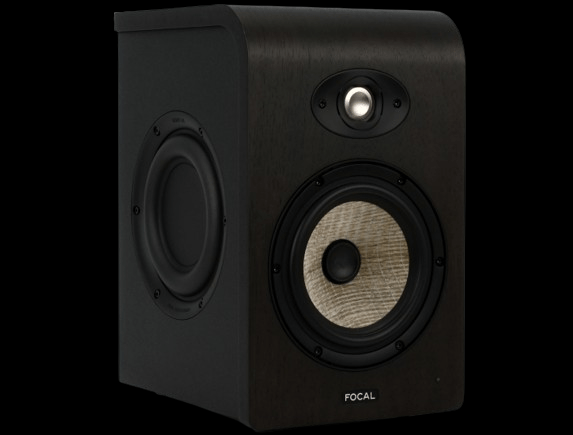
| Power | 80w mid and low freq, 25w high freq |
| Frequency response | 40 Hz – 35 kHz |
| Inputs | XLR, RCA |
| Digital connectivity | No |
| Dimensions (WxHxD) | 8.6 x 14 x 11.2 in / 21.8 x 35.6 x 28.4 cm |
| Weight | 28.2 lbs / 12.8 kg |
Pros
- Exceptional Sound Quality: The Focal Shape 65 is celebrated for its outstanding sound quality, delivering expansive, neutral sound with excellent detail across the frequency spectrum.
- Innovative Design: Features a unique flax cone and an M-shaped inverted dome tweeter, contributing to its high-fidelity audio performance and reduced distortion.
- Wide Sweet Spot: Offers a wide sweet spot, thanks to its design, making it easier for the user to move around the studio without losing the audio focus.
- Low Directivity Tweeter: Ensures that the sound remains consistent, even when listening from off-axis positions, enhancing the flexibility of studio layouts.
- Tonal Balance: Maintains an excellent tonal balance at both low and high volumes, making it suitable for various types of audio work.
- Room Correction: Includes room correction features with adjustable controls for the low and high frequencies, allowing for optimized performance in different acoustic environments.
Cons
- Bass Response: While excellent in overall quality, some users might find the bass response to be less pronounced than expected, potentially requiring a subwoofer for the most demanding low-frequency work.
- Size and Weight: These monitors are relatively large and heavy, which could pose challenges for smaller studio spaces or for those requiring a mobile setup.
- Complexity for Casual Users: The advanced features and detailed tuning capabilities might be more than what a casual user or hobbyist would require.
Boasting an elegant design that blends seamlessly into any studio environment, these monitor speakers not only captivate with their visual appeal but also excel in sonic accuracy and placement versatility. The standout feature lies in their bass response, which offers a richness and depth that belies their compact stature. This remarkable bass performance can be attributed to the innovative application of technology derived from the development of the SM9’s passive radiator, showcasing Focal’s engineering prowess.
For aficionados seeking recording studio speakers that provide an authentic, revealing listening experience with a harmoniously balanced and natural sound profile, the Focal Shape 65 emerges as a paramount choice. Its capabilities make it an indispensable asset for critical listening and professional audio production, deserving a spot at the top of any audition list for those dedicated to achieving the pinnacle of sound quality in their recordings.
M-Audio BX4: Great Mixing Monitors
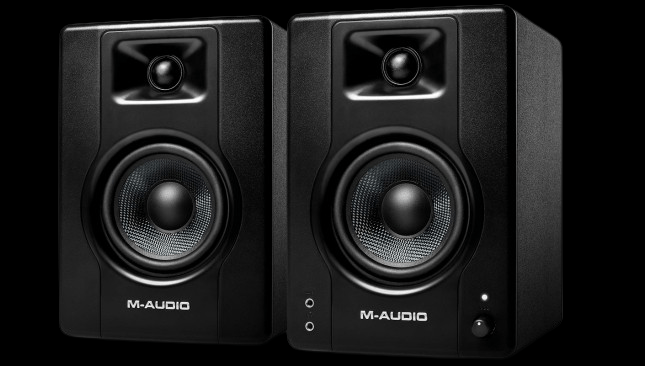
| Power | 120 W |
| Frequency response | 69 Hz – 22 kHz |
| Inputs | RCA stereo input pair, 1/4″ (6.35 mm) TRS inputs, 1/8″ (3.5 mm) stereo auxiliary input |
| Digital connectivity | No |
| Dimensions (WxHxD) | 6.1 x 8.9 x 6.9 in / 15.6 x 22.5 x 17.5 cm |
| Weight | 9.83 lbs / 4.46 kg |
Pros
- Affordability: The M-Audio BX4 monitors are very budget-friendly, making them an excellent choice for beginners, hobbyists, or those setting up a home studio without a large investment.
- Versatile Connectivity: Offers versatile connectivity options, including 1/4″, 1/8″, and RCA inputs, allowing easy integration with various audio sources.
- Compact Design: Their compact size makes the BX4 ideal for small studio spaces, desktop setups, or multimedia applications where space is at a premium.
- Sound Quality for the Price: Despite their low price point, the BX4 monitors provide a decent sound quality that can be satisfactory for basic mixing, production work, and casual listening.
- Aesthetic Appeal: Features a sleek, modern design that looks great in any studio environment or on a desk setup.
Cons
- Limited Low-End Response: The smaller drivers and cabinet size mean the BX4s have a limited low-end response, which might not be suitable for genres that require deep bass without adding a subwoofer.
- Not Ideal for Professional Mixing: While they offer good value, the BX4 monitors may not meet the critical listening requirements needed for professional mixing and mastering due to their frequency response and sound accuracy limitations.
- No Room Correction Features: Lacks advanced room correction features, which might be a drawback for those trying to achieve the best sound in acoustically challenging environments.
Affordably priced, these compact M-Audio speakers shine in limited spaces, making them a smart pick for DJ practice, podcast creation, livestreaming, and crafting beats, aligning well with the needs of creative enthusiasts. Their stature, however, suggests a cautious approach for those engaged in comprehensive music production tasks, as their size limits the accuracy obtainable compared to higher-end alternatives. Nevertheless, they stand out as an excellent choice for a supplementary set of “reference” speakers within a more expansive studio setup, offering valuable perspective when assessing mixes, a key consideration in the search for the best speakers for mixing. Their utility in such a dual capacity reinforces their appeal to audio professionals and hobbyists alike.
Adam Audio T5V: High-Quality Nearfield Monitors
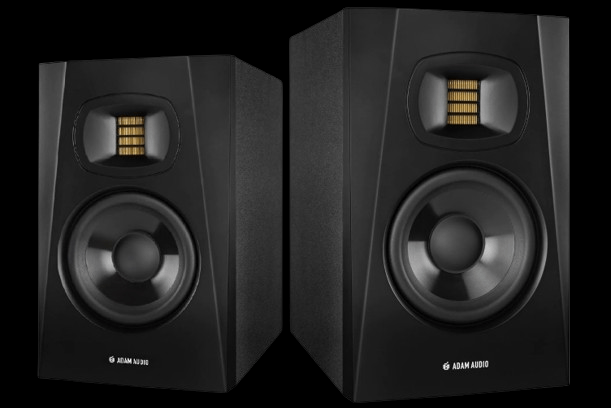
| Power | 50 W |
| Frequency response | 45 Hz – 20 kHz |
| Inputs | RCA, XLR |
| Digital connectivity | No |
| Dimensions (WxHxD) | 7 x 11.7 x 11.7 in / 17.8 x 29.7 x 29.7 cm |
| Weight | 12.6 lbs / 5.7 kg |
Pros
- High-Quality Sound: The Adam Audio T5V is known for its detailed and accurate sound reproduction, especially in the mid and high frequencies, thanks to its U-ART ribbon tweeter.
- Wide Sweet Spot: The tweeter’s design allows for a wider sweet spot, offering flexibility in monitoring positions within the studio.
- Powerful Bass Response: Despite its compact size, the T5V delivers a surprisingly powerful and precise bass response, suitable for various music genres.
- High-Performance Amplification: Features built-in Class D amplifiers that provide robust and efficient power output to each driver, ensuring clear sound at all volume levels.
- Compact and Durable Design: The T5V’s compact design makes it suitable for small studio spaces, while its build quality ensures durability and longevity.
- Affordable Price: Offers excellent value for its price, making high-quality sound accessible to home studios and professional environments alike.
Cons
- Bass Extension: For some users, especially those working with bass-heavy music, the T5V’s bass extension might not be sufficient, potentially necessitating a subwoofer for full-range sound.
- Limited Low-End Accuracy: While the bass is powerful, it may lack the accuracy and definition found in higher-end models, affecting critical mixing decisions in the low-end.
- Rear Port Design: The rear-ported design requires careful placement in the studio to avoid bass frequency buildup, which might not be ideal in smaller or untreated rooms.
- No Bluetooth Connectivity: Lacks Bluetooth or wireless connectivity options, which could be a drawback for users seeking flexible streaming capabilities.
Adam Audio’s T5V emerges as an incredibly budget-friendly choice among the best audio monitors, crafted with a 5-inch woofer and the proprietary U-ART tweeter. This compact model boasts Class-D amplification and a sophisticated rear-ring bass reflex system, making it a standout in the T Series for its size and performance.
Exceptionally tuned highs and a broad horizontal sweet spot, courtesy of the HPS waveguide, significantly boost imaging and separation, showcasing superior soundstage depth. Despite its deeper cabinet, it retains a sleek profile. Enhancing the lower midrange is straightforward with a minor LF EQ adjustment. Adam Audio aims for the T5V to be an introductory monitor that wins over users for life, a goal it meets with ease, solidifying its status among the best audio monitors for newcomers and seasoned users alike, promising unparalleled quality and lasting appeal.
Focal ST6 Solo6: Premium Music Production Speakers

| Power | 130 W |
| Frequency response | 40 Hz – 40 kHz |
| Inputs | XLR |
| Digital connectivity | No |
| Dimensions (WxHxD) | 9.75 x 13.12 x 11.62 in / 24.8 x 33.3 x 29.5 cm |
| Weight | 28.6 lbs / 28.9 kg |
Pros
- Exceptional Sound Quality: The Focal ST6 Solo6 delivers outstanding audio clarity, precision, and neutrality, making it ideal for critical listening and professional mixing and mastering tasks.
- Advanced Driver Technology: Incorporates Focal’s exclusive Beryllium inverted dome tweeter and ‘W’ composite sandwich cone, offering unparalleled dynamic range, low distortion, and detailed sound reproduction across the frequency spectrum.
- High SPL Capability: Producing high sound pressure levels without distortion, ensuring clear and detailed sound even at high volumes, suitable for a wide range of professional audio applications.
- Versatile Room Integration: Features extensive room integration and tuning controls, including high, mid, and low-frequency adjustments, allowing for optimal performance in various acoustic environments.
- Robust Build Quality: The ST6 Solo6 is built to Focal’s high standards, featuring a sturdy construction that promises durability and longevity in demanding professional settings.
- Compact and Efficient Design: Offers a compact footprint without compromising sound quality, making it suitable for smaller studios where space is at a premium.
Cons
- Bass Response: While exceptional in clarity and detail, some users may find the low-end response less pronounced compared to larger monitors or those specifically designed for bass-heavy genres without adding a subwoofer.
- Complex Tuning Features: The advanced tuning features, while beneficial for seasoned professionals, may present a learning curve for beginners or those not used to detailed sound customization.
- Weight and Portability: The monitor’s robust build and quality materials add to its weight, making it less portable than lighter models, which could be a consideration for those needing mobile setups.
The Solo6 stands out for its exceptional transparency, delivering pure, unaltered sound that garners trust from its users. This clarity is complemented by the tweeter’s remarkable responsiveness, ensuring every detail is captured with precision. Additionally, its minimal distortion allows for extended listening sessions without listener fatigue, embodying the pinnacle of comfort in audio monitoring. Positioned at the rear, comprehensive EQ settings adjust the output to perfection, regardless of the acoustic environment. While acquiring a set represents a significant investment, the value they bring to any setup is undeniable, offering a perfect equilibrium of cost and quality. These monitors are not just tools but treasures within the realm of production speakers, enhancing the capabilities of compact recording environments.
Top Monitor Speakers: Buying Advice
Exploring the diverse universe of music studio speakers reveals an array of shapes, sizes, and functionalities, underscoring the importance of finding the right match for your needs.

Amplification Is Essential
Signals from a mixer or audio interface in a home studio are typically low in strength, necessitating an amplifier’s boost. Active monitors integrate this amplifier internally, offering a convenient solution, whereas passive speakers require an external amplifier to function.
Monitor’s Layout Is A Key
The configuration of the speakers plays a pivotal role as well. Traditional two-way speakers feature a woofer for low frequencies and a tweeter for higher ranges, with a crossover filter dividing the signal into separate bands. To avoid muddying crucial midrange frequencies, more sophisticated three-way or four-way systems incorporate additional drivers, enhancing clarity in those vital areas.
Size Does Matter
The size of the monitor impacts its performance, particularly in terms of power and bass output. The dimensions of your room and its acoustic properties should guide the selection of monitor size to avoid overwhelming the space.
Consider In-Room Placement
Placement within the room also demands attention. Nearfield monitors are designed for close proximity listening in smaller studios, while midfield monitors are suited for larger spaces, positioned further from the listener. In professional settings, large, full-range mains dominate, providing comprehensive sound coverage. Monitor size, often determined by woofer diameter, ranges significantly, with nearfield monitors typically sufficient for small to medium-sized rooms.
Conclusion
Studio monitors are designed to unveil the full spectrum of your music with utmost honesty. Ideally, they possess a flat frequency response, ensuring no frequencies are exaggerated or diminished, allowing you to experience the mix in its purest form. This fidelity enables precise adjustments in your mix (such as volume modulation or EQ tweaks) grounded in the accurate sound reproduction provided by the monitors.


